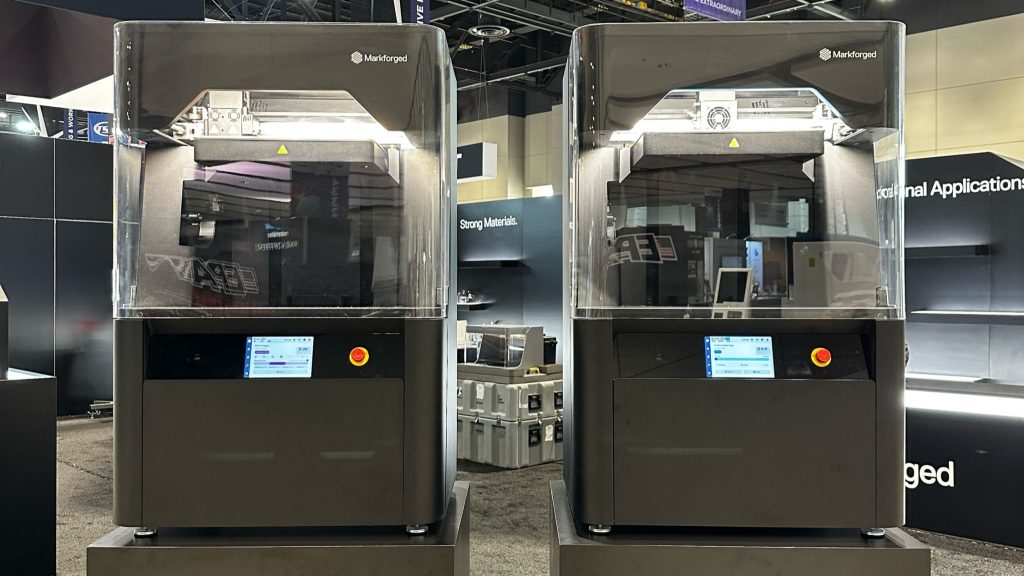About a year ago, 3D printer manufacturer Markforged updated its FX10 composite printer with a print engine adapter that allows printing with two stainless steel filaments. A recent feature with automotive shop Graham Rahal Performance (GRP) shows the system being used for both composite and metal parts. The combination of 3D printing and traditional fabrication methods has broadened GRP’s production capabilities in custom automotive work.

Efficiency, Precision, and Innovation in Practice
Rob Sorum, GRP Fabrication Specialist, explained the challenges he faced before 3D printing became part of the workflow. “When I started at the shop, I handled all aspects of fabrication myself, from design and engineering to welding and assembly. It’s a long process. And that is the downside of only having one person there: you’re down for a month designing something else, and if another thing needs to be made, it has to go on the back burner,” he says.
Sorum explained that the FX10 has improved efficiency at GRP. “If I could shave 20 hours off building a fixture, yeah, sign me up. What Markforged has done for us is basically like having that second hand. It was just a lot more cost effective. I can design an exhaust in CAD, grab the part out of the printer, and I don’t have to spend 20, 30, sometimes 40 hours hand-building these fixtures. There’s no machining afterwards, no extra tools needed, no deburring knives or anything. You just print it. It’s easy,” Sorum says.
One recent project demonstrates the full potential of 3D printing: the Lamborghini Revuelto exhaust system. “We wanted to throw the gamut of all of our tools at it, starting with our waterjetted flanges, to laser etching. And the pinnacle, what makes it the most unique out of any other system out there, is our Markforged 316L Stainless Steel flanges for the X pipe on this system,” he explains. The X pipe enhances exhaust flow, increasing horsepower by optimizing scavenging.
Beyond exhaust systems, GRP uses 3D printing to produce clamps and fixtures that protect expensive components without sacrificing strength. “I’m not a professional machinist. I didn’t go to school for that. I’m a fabricator who found a necessity for something, and Graham saw it too. It has been ideal for us. Sometimes, you can’t get a better injection-molded part. Your part is perfect—put it on,” Sorum adds.
Additive Manufacturing in High-Performance Automotive Design
In July, British automotive manufacturer McLaren Automotive partnered with California-based manufacturing technology firm Divergent Technologies to develop a series of 3D printed suspension components for the McLaren W1, the company’s latest high-performance hybrid supercar. This collaboration leverages additive manufacturing to produce structurally optimized parts—such as the front upper wishbone, aero-profiled lower wishbone, and front upright—engineered to meet stringent requirements for stiffness, durability, and aerodynamic performance.
Elsewhere, Conflux Technology, an Australian company specializing in heat transfer solutions, announced a collaboration with Italian hypercar manufacturer Pagani to address thermal management challenges in the Pagani Utopia’s transmission. The Utopia, Pagani’s latest hypercar, uses a 6-liter twin-turbo V12 engine designed by Mercedes-AMG. Its powertrain integrates a custom seven-speed transmission developed by Xtrac, available in both automated and manual configurations, to deliver the high levels of control and responsiveness required in extreme driving conditions.
Want to help shape the future of AM? Join the Expert Committee for our 2025 3DPI Awards, launching later this summer.
To stay up to date with the latest 3D printing news, don’t forget to subscribe to the 3D Printing Industry newsletter or follow us on Twitter, or like our page on Facebook.
While you’re here, why not subscribe to our YouTube channel? Featuring discussion, debriefs, video shorts, and webinar replays.
Image featured shows FX10 printers. Photo via Markforged.
